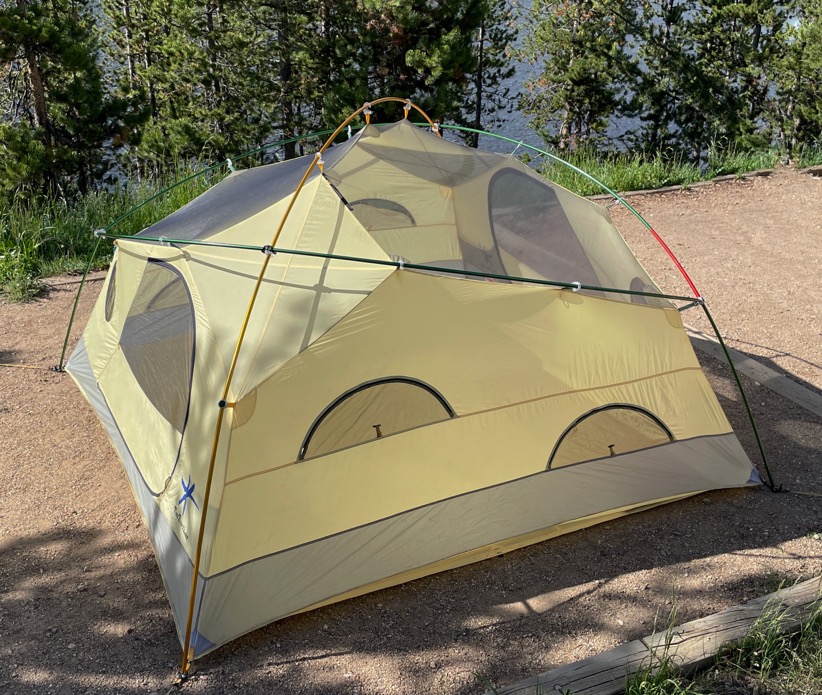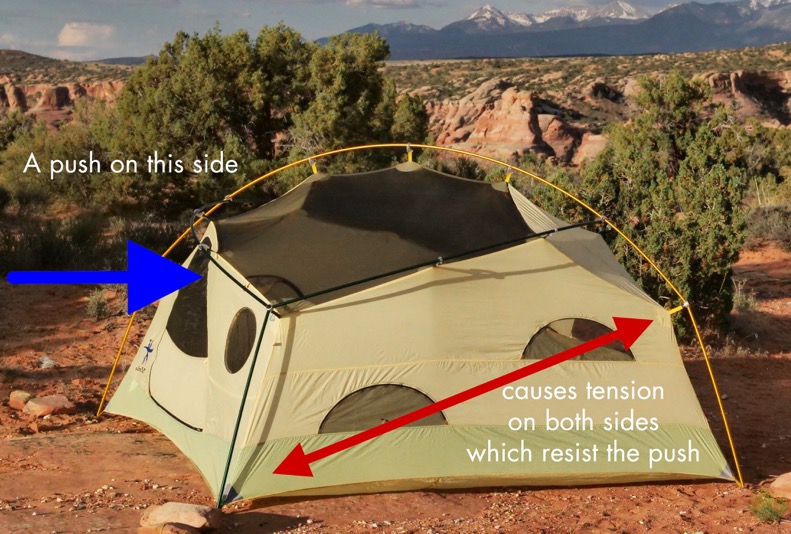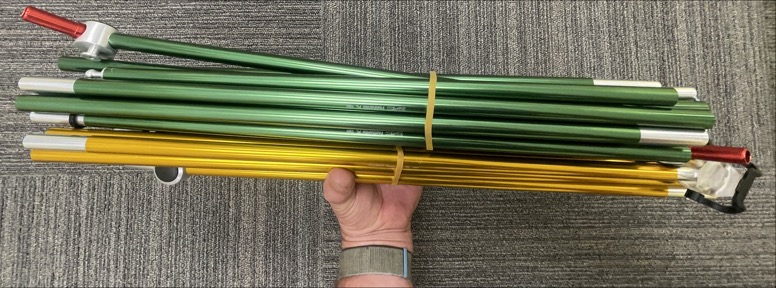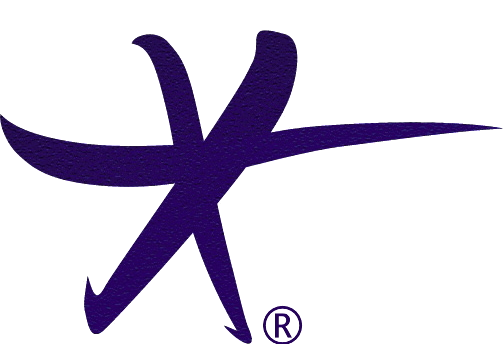The MoonLight 2, 2+, 3+, & 4+ Tents
Latest MoonLight tent NEWS:
Preorders are closed (but regular orders are open)
• Short 3-minute New video on finding the sweet spot for taking apart the MoonLight 2+, 3+ and 4+ EyePoles
• Not Short new video on all the ins and outs of setting up and taking down MoonLight 2+, 3+ and 4+ tents
• New 5-minute video on the wind tunnel test of the MoonLight 2 v2
A new setup/takedown video and explanation of the features and gizmos:
• Have we mentioned yet that our tents are fire retardant and fluorocarbon free? Yup!
I’m an old tent designer and the MoonLights are the only ones that I've chosen to bring to market and to champion myself. What’s different about them is their uncompromising focus on what I think a tent should provide: reliable, worry free, and quiet shelter to sleep and live in, even camped completely out in the open.
It’s a very different mindset in a market where saving weight and cost are the supreme priorities. Specifically the MoonLights’ design is better in three ways:
They’re exceptionally strong and quiet.
They easily handle difficult weather and site conditions (without sagging).
And they’re really nice to be in and use.
Navigating this site is a lot different from most. Usually you’ll land on a product page and the photos and BUY button are the focus. Below that will be a list of specs and features with little or no explanation. This site is ALL explanation and all its topic pages are in the menu to the left, but to give you a good start, let me offer the navigation paragraph below with some page links:
Because I believe that reliability and quietness are the most basic requirements for a tent, the strength discussion starts immediately below. Afterwards I recommend the problems solved and no-sagging discussions. Many will want the weights and features list. There's a lot to like in a MoonLight: from pitching easily pretty much anywhere, to not dripping condensation on you, to not having the polyurethane degrade with age, to their very pleasant and gently uplifting interior features, shapes and colors. That should get you started. The prices and the buy buttons are on the order page.
Did you bring your mask and fins? Yes? Excellent! You are surprisingly well prepared. Let’s first jump right into the MoonLight’s - or any tent’s - most essential part: its pole structure. Based on achieving the goals above, the priorities for the MoonLight pole structure were that it create a roomy and aesthetic space inside, be strong in every direction, and be as lightweight as possible. From this DNA came the design of the MoonLight’s pole structure; the “bones” of the tent (a), if you will. 
1) The MoonLight Pole Structure
One thing about the MoonLight’s pole structure probably jumps out at you immediately: it’s kind of boxy.
The corners are almost vertical and above those corners are green poles (called the Eyepoles because they form an eye-like shape 👁️ when viewed from above) which arc across the top, forming a top edge for the tent on all four sides. These poles support the walls directly from above and span the tent front-to-back on all sides. This creates a structure where a push on any side is transferred by the green poles to a push on the back side as well. In addition there’s the gold Ridgeline pole which gives the tent an unambiguous high-point for the rainfly to shed rain from(b). Because the EyePole and Ridgeline poles are locked together(c) at the intersections, the MoonLight poles produce a genuine UNITIZED structure. 
2) The MoonLight Fabric is an Integral Part of the Structure
An interesting effect that is true to some degree in any tent is that the fabric walls reduce the movement of the poles. Specifically, if you push on the front of a tent, you can see that the fabric on both sides are reducing the motion of the rear of the tent — essentially the sidewalls are acting sort of like guylines connecting the front anchors to the rear poles(d). With most tents, however, most of this strength is lost because of the flexibility of the poles and because the clips slide, so they’re not effectively holding the poles in place.
The MoonLights make use of a type of clip, called an H-clip(c), that locks to the poles at the hubs and select joints, so the pole can’t move independently from the inner tent. This increases the rigidity and, for a tent, rigidity is pretty much the definition of strength (and it’s most definitely the definition of its usability in a wind). 
3) Big Fat Poles Complete the Circuit (our 13.55mm DAC PL poles shown)
A unitized pole design reinforced by the tent body (and rainfly, in another discussion) adds a lot of design driven strength but none of it matters if the rear of the tent can’t transfer support to the front. This requires one or more poles that are stiff enough and strong enough to do that job and this is exactly what’s been removed from most tents today for the sake of weight savings (e). MoonLights use large diameter DAC PL poles which have the highest strength (or stiffness) weight efficiency of any tent poles. The smallest diameter pole that we currently use is 12.1mm (in our ML2v2). Our “+” tents all use 13.55mm poles. For comparison, most two-person tent poles are from 8.5mm to 9.3mm in diameter and 4-person tents use up to 11mm.
How well do the MoonLights meeting their strength-in-all-directions goal? Here are the WIND TUNNEL TEST results. Very good results indeed! MoonLight tents handle winds about double what regular tents can, which equates to being four times stronger (force goes as the wind speed squared). We use some pretty fat poles so if you account for those in the ML2v2, for instance (they're roughly twice as strong as regular poles), that means the design alone accounts for the other 2X. Details and data here. 
All right, that was a nice scratch-the-surface for the "exceptionally strong" goal. The navigation bar to the left provides more information on strength and the other goals. Perhaps the problems solved and no-sagging discussions would be good to read next?
Oh right! The BUY buttons…are here.
_______________________________________________
a) My good friend, David Mydans, tent designer (and more) at REI from 1988-2015, is particularly fond of this poetic metaphor for the fundamental essence of his tent “babies.”
b) Also extremely important for dealing with condensation on the underside of the rainfly.
c) We use the absolutely brilliant DAC components for this feature. They were invented by Jake Lah, the owner of the tent pole company DAC. Oddly, we’re one of the few manufacturer’s using them.
d) If you used actual guylines this way, it would the “Internal Guy System” invented in the 1980s by Paul Kramer at Sierra Designs and the strength hack we had for our ML2 v1.
e) Many of the lightest weight modern tents are based on variations of the close-to-minimum tent pole design first used in the Walrus Rapeede tent, invented by George Marks in the late 90s. This design used 3-way hubs front and back with a single lengthwise pole spanning the middle. Adding a single single cross pole on top holds the long sidewalls of the tent up and outward.
f) To be clear, what I'm claiming is that PL poles are the lightest of any similar strength (or stiffness) aluminum poles. Weight efficiency goes up with bigger outside diameters, so the ultimate strength-to-weight pole has a large outside diameter with walls as thin as possible.
